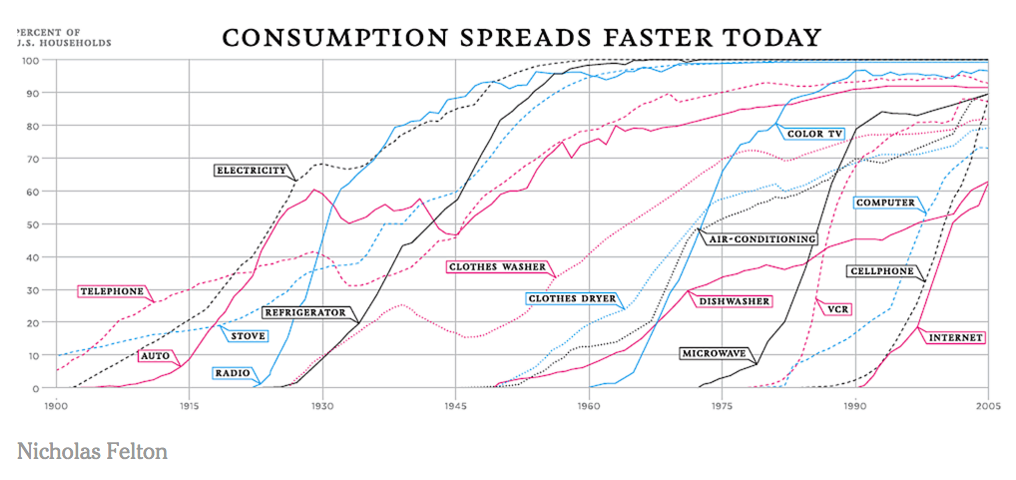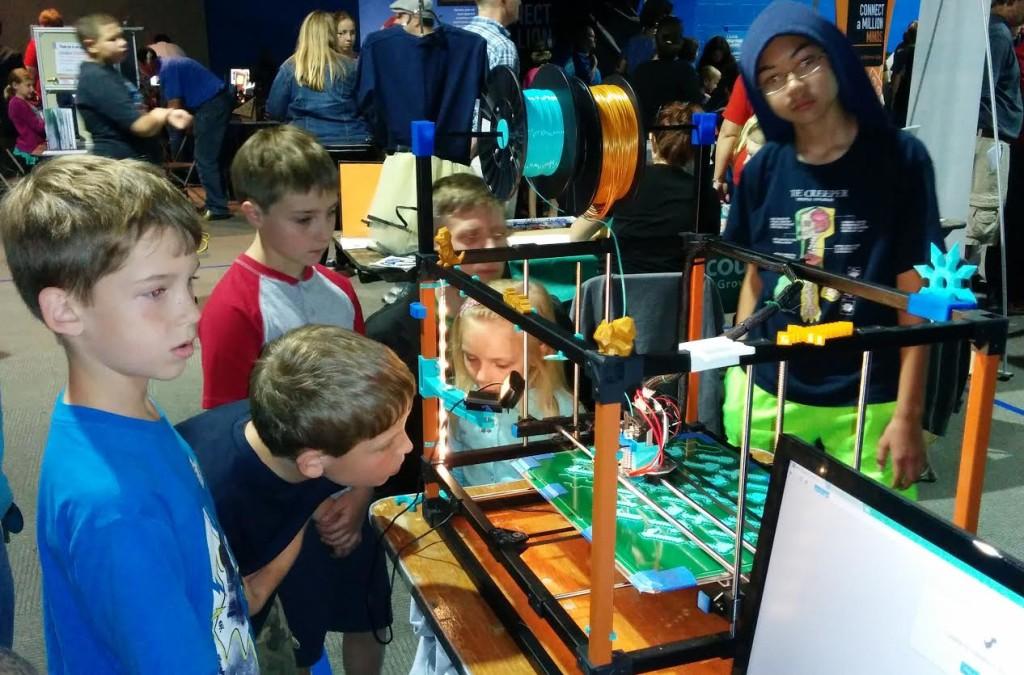I thought I’d start this article with a quote from one of my absolute favorite science fiction writers ever (Kurt Vonnegut is a very close second!)
“I’ve come up with a set of rules that describe our reactions to technologies:
- Anything that is in the world when you’re born is normal and ordinary and is just a natural part of the way the world works.
- Anything that’s invented between when you’re fifteen and thirty-five is new and exciting and revolutionary and you can probably get a career in it.
- Anything invented after you’re thirty-five is against the natural order of things.”
— Douglas Adams
Lately, it seems the 3D printing industry is following that trend. More and more companies are changing their target audience. They’re moving away from selling boxes to consumers and are instead focusing on solutions for education.
MakerBot’s Pivot
Back in May, 2015, MakerBot announced that it would reduce its emphasis on consumers, and instead focus on the educational and professional markets.
At the time, MakerBot CEO Jonathan Jaglom said that, “MakerBot initially addressed the right market—basically the makers, the tinkerers, the DIYs—but as MakerBot grew so did the audience space, and so then the education came in and the professional came in, and that today is becoming a much wider audience than the consumer.”
For what it’s worth, Jaglom did note that the consumer market, “is there; we have people that own printers at home. It’s not a negligible community, but it’s not as big as we initially perceived.”
A 3D Printer in Every Home?
Mr. Jaglom might have been a bit optimistic when he added this. “If you ask me, five to seven years from now, I really do believe there will be a printer in every person’s home,” he said. “And we’re gonna work to get to there.”
Certainly technology adoption is getting faster. This famous Nicholas Felton graphic, featured in the New York Times, does a great job of illustrating that:
But a 3D printer in every home by 2020? Most of the estimates I’ve seen show the industry selling maybe 5 million printers annually by then. More likely we’re decades away from that – if it ever happens.
How then, will the industry scale? I don’t think it will happen in the home. People don’t want the machine, they want what comes out of it. They don’t want a bread maker, they want bread – and I say this with some experience. We had a bread making machine in our house for seven years and it never once made it out of the packaging. It recently took a one-way trip to the island of misfit appliances.
Create a Need, Then Fill It
One of the problems with 3D printing is that there are so few creators. I’m guessing that fewer than one million people on the planet have the necessary computer-aided design (CAD) skills to create usable, 3D printable products. A large majority of them use CAD for things that are completely unrelated to 3D printing.
So, how do we get more people involved? We can start by making it simpler to design in three dimensions. CAD needs to be easier and more intuitive. It reminds me of high school geometry, and for me at least, geometry was neither easy nor intuitive.
Also, to the late great Douglas Adams’ point, if you want a technology to seem “normal and ordinary” you’ve got to wean people on it. Get them interested as early as possible. Schools.
From Software to Apps and Beyond
If anyone gets the problem, it’s a company like like Dassault Systèmes, the maker of SOLIDWORKS. They know they need to make 3D design easier and they need to reach people at an earlier age. To that end, they’ve launched Apps for Kids, which breaks CAD up into smaller, less intimidating, more intuitive modules.
“We have done a lot of research studying gaming and social media that children are jacked into,” noted Chinloo Lama, a senior user experience design engineer at Dassault Systèmes SOLIDWORKS.
“This idea of learn-as-you-do in the apps, kids are familiar with. There is no longer any help documentation. We are looking at a lot of video and picture-in-picture as a kid will look at YouTube and templates to get ideas. These elements will be injected as user assistance, but not the traditional help menus.”
The World is Mobile
As much as it’s a problem of how to reach and expose kids to 3D design, it’s also a problem of where to reach them. Traditionally CAD has been a desktop application. Children are mobile. In fact over 50% of 8-to-12-year-old children in the US have their own cell phone. 88% of teenagers have one.
And they’re getting access even earlier. A recent study found that by age 2, more than half had scrolled screens, called someone, watched a TV show on the device, played video games or used an app.
There’s an App for That
Could CAD software eventually be replaced by an endless number of apps, each designed to help people create very specific 3D printable products?
Consider Let’s Create! It is a popular app that allows you to make custom pottery:
It’s designed for mobile, taking advantage of the technology available in modern smartphones to create an experience that is much more user friendly than any CAD software. It’s also highly gamified and has a thriving online community. You can even 3D print your creations via Sculpteo’s 3D printing service.
Would it be that hard to imagine a similar app for fishing lures or eyeglasses?
AI Changes The Game
Of course, we could move beyond apps entirely. Artificial intelligence might eliminate the need. In a recent interview, Google director Aparna Chennapragada said she thinks we’ll eventually “…de-silo and unbundle the function of apps.”
Does that mean apps will go away? Ms. Chennapragada went on to say that, “Google has made some ‘early steps’ with app indexing, letting you search inside apps.” But even now, “it’s so difficult for users to jump between these contexts, jump between these apps. And what we’re saying is that needs to be far more fluid … [It’s] less about shrinking them, or obliterating parts of the app, but about saying: ‘There’s so many more places where parts of your app can surface’.”
It’s likely we’ll see a lot of ebb and flow with apps over the next few years. While the way we access them might vary, dedicated apps will continue to proliferate, and could have the potential to play a big role in how 3D printed products are created and customized.
The Pool’s Getting Crowded
In the future, virtual reality might be so good we won’t need a lot of the products we use today. That’s then and this is now. When training people to design in 3D, physical versions are indispensable. They give people a way to touch and feel what they’re visualizing on screen.
And that’s why 3D printer manufacturers are so interested in the educational market. With all of the effort going into training kids to think of 3D design as “normal and ordinary,” having a printer nearby is crucial.
Today, there are over 3 billion people globally who have access to the Internet, and most of them connect from a mobile device. That number is growing exponentially. As Google director Chennapragada put it, “5 billion people will be online in five years, and suddenly this actually has the ability to affect the real world … we want to make sure that we’re building the blocks right.”
That’s as true for artificial intelligence as it is for 3D printing. We’ve got a small window of time before millions (and maybe billions) of people can find, create, and customize 3D printable content. We’ve got to make sure that we’re also “building the blocks right,” or maybe more aptly in this case, building the voxels correctly.
In a future article, I’ll take a look at some of the other 3D printing equipment manufacturers who are focused on the educational market and discuss how their approaches differ. Some will fail and others will succeed, but collectively, the more they can do to improve access and the user experience, the more likely 3D printing will become the mega industry we all want it to be.
On that note, I’ll end with one more from Mr. Adams:
“Most of the time spent wrestling with technologies that don’t quite work yet is just not worth the effort for end users, however much fun it is for nerds like us.”
__________________________________
John Hauer is the Founder and CEO of Get3DSmart, a consulting practice which helps large companies understand and capitalize on opportunities with 3D printing. Prior to that, John co-Founded and served as the CEO of 3DLT. The company worked with retailers and their suppliers, helping them sell 3D printable products, online and in-store.
John’s original content has been featured on TechCrunch, QZ.com, Techfaster.com, 3DPrint.com and Inside3DP.com, among others. Follow him on Twitter at @Get3DJohn.
Subscribe to Our Email Newsletter
Stay up-to-date on all the latest news from the 3D printing industry and receive information and offers from third party vendors.
You May Also Like
Gorilla Sports GE’s First 3D Printed Titanium Cast
How do you help a gorilla with a broken arm? Sounds like the start of a bad joke a zookeeper might tell, but it’s an actual dilemma recently faced by...
Nylon 3D Printed Parts Made More Functional with Coatings & Colors
Parts 3D printed from polyamide (PA, Nylon) 12 using powder bed fusion (PBF) are a mainstay in the additive manufacturing (AM) industry. While post-finishing processes have improved the porosity of...
$25M to Back Sintavia’s Largest Expansion of Metal 3D Printing Capacity Since 2019
Sintavia, the digital manufacturing company specializing in mission-critical parts for strategic sectors, announced a $25 million investment to increase its production capacity, the largest expansion to its operations since 2019....
Velo3D Initiates Public Offering in a Bid to Strengthen Financial Foundations and Drive Future Growth
Velo3D (NYSE: VLD) has been among a number of publicly traded 3D printing firms that have attempted to weather the current macroeconomic climate. After posting a challenging financial report for 2023,...
































